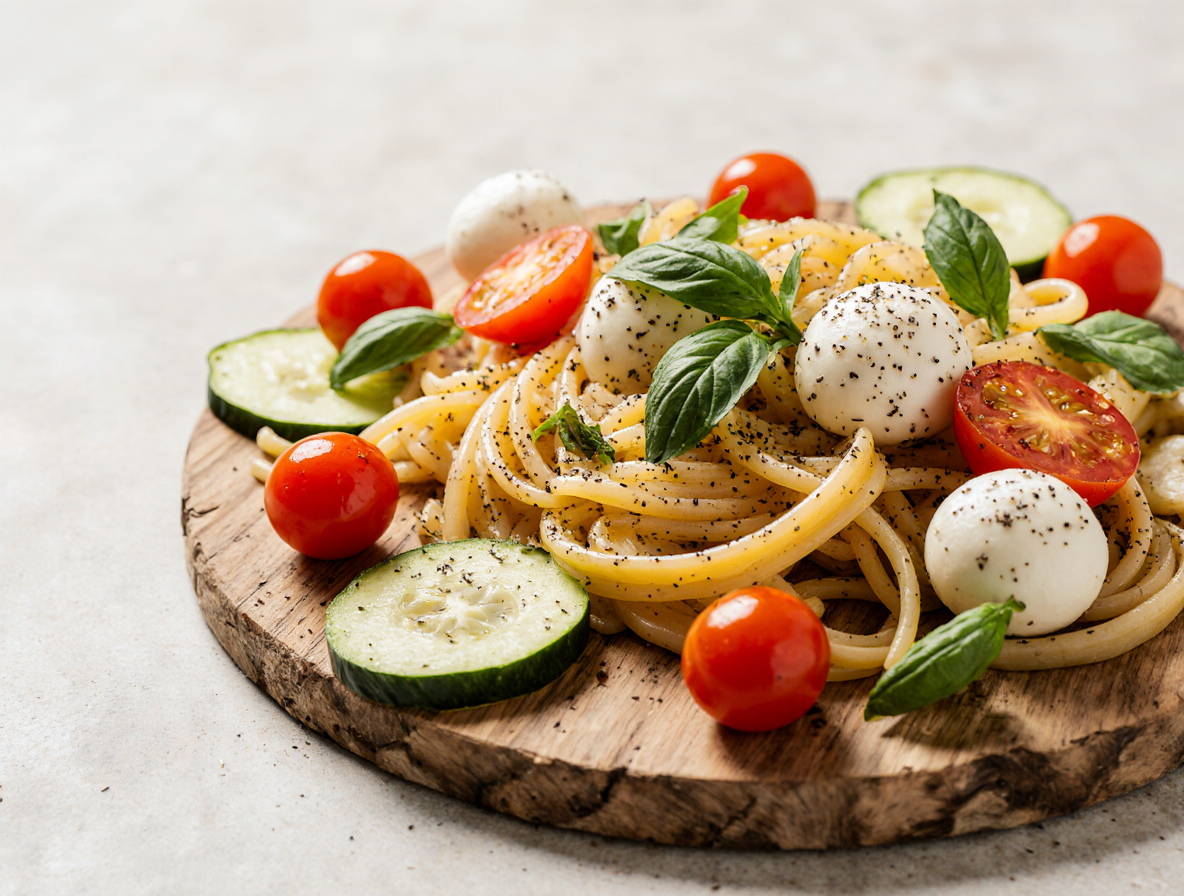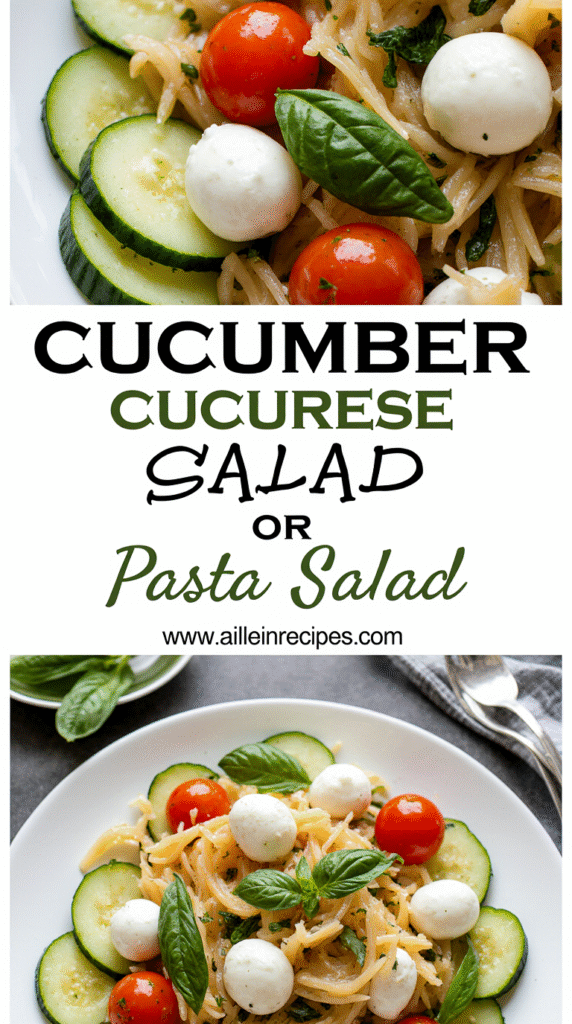How to Make the Perfect Cucumber Caprese Salad: A 15-Minute Italian Classic
Have you ever made a caprese salad with cucumber for a refreshing twist on the Italian classic? I make this vibrant dish at least twice a week during summer months when gardens overflow with fresh produce.
This cucumber tomato mozzarella salad is remarkably simple to prepare, requiring just 15 minutes and 5 main ingredients. In fact, the beauty of this dish lies in its straightforward approach — juicy tomato slices, fresh mozzarella, crisp cucumber, aromatic basil, and a drizzle of good olive oil and balsamic. Additionally, it’s hard to beat the satisfaction of a midsummer caprese when cucumbers add both crunch and color to the traditional recipe.
Whether you’re serving it as a side dish with burgers and steak or transforming it into a hearty pasta salad for your next summer BBQ, this recipe offers endless possibilities. Throughout this guide, we’ll explore everything from ingredient selection to creative variations that make this salad a staple in my kitchen.
Let’s dive into creating the perfect cucumber caprese that not only tastes better with time as flavors meld together, but also brings a taste of Italian summer to your table any day of the week.
Gather Your Ingredients
The secret to an exceptional cucumber caprese salad lies primarily in selecting top-quality ingredients. Since this recipe features just a handful of components, each one plays a crucial role in the final flavor profile.
Choosing the right cucumber
For the crispest, most refreshing cucumber caprese salad, I prefer English cucumbers. They offer thin, mild skin and smaller seeds than other varieties, making them perfect for salads. Persian cucumbers work wonderfully as well, while garden cucumbers typically require peeling due to their thicker, sometimes bitter skin. Look for firm cucumbers with uniform dark green color and no soft spots or wrinkles, which indicate age.
Best tomatoes for flavor
Heirloom tomatoes are your premier choice for caprese, offering bold flavors that grocery store hybrids simply can’t match. Their whimsical shapes and vibrant colors add visual appeal too. For smaller options, sweet grape or cherry tomatoes work beautifully, providing juicy bursts of flavor. The key is finding ripe, in-season tomatoes that smell fragrant and feel heavy for their size.
Fresh mozzarella options
Fresh, water-packed mozzarella creates the authentic caprese experience. For this cucumber variation, small mozzarella balls (pearls or ciliegine) provide perfect bite-sized portions. Alternatively, fior di latte (cow’s milk mozzarella) offers consistent quality, while mozzarella di bufala (buffalo milk) delivers a richer, creamier texture for special occasions. Either way, the cheese should be soft and milky.
Why fresh basil matters
Fresh basil is non-negotiable in caprese salad – dried simply won’t do. The herb provides essential aromatic compounds like linalool and methyl chavicol that complement the richness of mozzarella and acidity of tomatoes. Hand-tear basil leaves rather than cutting with a knife to prevent oxidation.
Balsamic glaze vs. vinegar
While traditional Italian caprese doesn’t use balsamic, many modern versions incorporate it. Balsamic glaze (reduced vinegar) offers a thicker, sweeter consistency perfect for drizzling. Regular balsamic vinegar is thinner and more acidic. You can make your own glaze by simmering vinegar until reduced by three-quarters.
Optional add-ins like red onion or avocado
For extra dimension, consider sliced red onion – I recommend marinating it briefly in balsamic first to mellow its sharpness. Avocado adds creaminess and healthy fats, though slightly under-ripe varieties hold their shape better in the salad. Even peaches or strawberries can create delightful variations for this versatile dish.
Step-by-Step: Making the Salad
Creating a cucumber caprese salad involves simple steps that allow these fresh ingredients to shine. I’ll walk you through the process of transforming basic ingredients into a stunning Italian-inspired dish.
Slice and prep all ingredients
Begin with a serrated knife to slice your tomatoes into 1/4-inch thick rounds. For larger beefsteak or heirloom varieties, some slices can remain as full circles while others can be cut into half-moons to create visual interest. Subsequently, prepare your cucumbers by either peeling them first or scoring the skin with a fork for decorative effect. Then slice the cucumber thinly crosswise or quarter them lengthwise before chopping into bite-sized pieces.
For the mozzarella, slice fresh cheese into 1/4-inch thick rounds to match your tomato thickness. Alternatively, you can tear the mozzarella into smaller chunks for a more rustic presentation or use pearl-sized mozzarella balls for convenience.
Finally, prepare fresh basil by hand-tearing the leaves instead of cutting them with a knife—this prevents oxidation and preserves more flavor. Smaller leaves can remain whole, while larger ones should be torn into smaller pieces.
Mixing the base ingredients
Arrange your ingredients in an overlapping pattern on a serving platter. Initially, you might place a layer of tomato slices, then tuck in cucumber, mozzarella, and basil leaves. For a layered approach, start with tomatoes as the base, then add additional ingredients, repeating the pattern. Furthermore, this arrangement allows each component to be visible and creates an appealing presentation.
Drizzling and seasoning
Once arranged, generously sprinkle with flaky sea salt and freshly ground black pepper. Afterwards, drizzle with extra-virgin olive oil, followed by balsamic glaze or vinegar. The olive oil and balsamic should be added just before serving for maximum visual impact.
Letting it rest for flavor
Perhaps the most crucial yet overlooked step is allowing your salad to rest. Let it sit for 10-15 minutes at room temperature before serving. This resting period permits the salt to draw out tomato juices, creating a natural dressing as flavors meld together. Moreover, herbs release their aromatics during this time, essentially transforming the individual ingredients into a cohesive dish.
Make It a Pasta Salad
Transforming your cucumber caprese into a pasta salad opens up a whole new dimension of possibilities. This heartier version works particularly well for potlucks, picnics, or make-ahead lunches.
Best pasta shapes to use
Short pasta shapes with texture excel in caprese pasta salad because their ridges and crevices hold onto dressing beautifully. Rotini, fusilli, and farfalle are classic choices, while cavatappi and orecchiette offer unique alternatives that cradle small ingredients perfectly. Shell pasta works wonderfully too, as its pocket-like shape captures bits of tomato and cheese.
How to chill and mix pasta
Cook pasta slightly past al dente—this prevents hardening once cooled. After draining, either rinse under cold water to stop cooking or spread on a baking sheet with a drizzle of olive oil. Consequently, when adding your cucumber caprese ingredients, ensure pasta has completely cooled to prevent wilting fresh basil.
Adjusting dressing for pasta
For pasta versions, you’ll need 1-2 extra tablespoons of balsamic glaze plus additional salt and pepper to properly flavor the pasta. Consider making extra dressing if preparing ahead, as pasta absorbs moisture while chilling.
Serving suggestions for pasta version
The pasta variation pairs excellently with grilled proteins like sausages, balsamic chicken, or herbed pork chops. Alternatively, incorporate proteins directly—diced chicken, shrimp, or even chickpeas make it a complete meal.
Flavor Variations and Add-Ons
Beyond the basic cucumber caprese lies a world of exciting flavor combinations worth exploring. These variations can transform your simple salad into something extraordinary for any occasion.
Adding grilled chicken or shrimp
For a heartier meal, grilled protein makes an excellent addition to cucumber caprese salad. Marinate chicken or shrimp in a simple lemon-herb mixture before grilling for optimal flavor. Cut the cooked protein into bite-sized pieces and gently toss with other ingredients. The smoky char from grilling creates a wonderful contrast with the fresh components. Alternatively, canned tuna works for a quick protein boost.
Using pesto instead of balsamic
Swapping balsamic for pesto creates a nutty, herbaceous twist on traditional cucumber caprese. The vibrant combination of basil, garlic, pine nuts and Parmesan cheese complements the sweetness of tomatoes beautifully. This variation works especially well when paired with grilled proteins or even as a pasta salad base.
Incorporating fruits like peaches or strawberries
Summer fruits add unexpected sweetness to cucumber caprese. Stone fruits like peaches, nectarines, or plums provide juicy contrast, alongside berries like strawberries or blackberries. For an elegant presentation, arrange sliced stone fruits with cherry tomatoes, strawberries, and fresh mozzarella before drizzling with aged balsamic.
Making it spicy with chili flakes
Introduce heat to balance the salad’s refreshing nature with red pepper flakes. Just ¼ teaspoon gives a pleasant warmth without overwhelming other flavors. Alternatively, try Calabrian chili oil or a dollop of spicy sauce made from sour cream mixed with hot sauce.
Conclusion
The cucumber caprese salad truly represents Italian cuisine at its finest – simple, fresh ingredients combined to create something extraordinary. Throughout this guide, we’ve explored how adding crisp cucumber transforms the traditional caprese into a refreshing summer staple that takes just 15 minutes to prepare.
Above all, remember that ingredient quality matters significantly when working with such a simple recipe. Fresh mozzarella, vibrant tomatoes, crisp cucumbers, and aromatic basil each play essential roles in creating the perfect balance of flavors and textures.
Additionally, don’t rush the process – allowing your salad to rest for those crucial 10-15 minutes before serving makes all the difference. This resting period ensures the salt draws out tomato juices, creating that natural, flavorful dressing that brings everything together.
The versatility of this dish makes it particularly special. You can enjoy it as a simple side, transform it into a hearty pasta salad, or customize it with countless variations – from adding proteins like grilled chicken to incorporating fruits or a spicy kick with chili flakes.
Finally, cucumber caprese celebrates the essence of summer cooking – minimal effort with maximum flavor. This refreshing dish will undoubtedly become a regular feature on your table during warm months, delighting family and friends with its vibrant colors and perfectly balanced taste. My kitchen wouldn’t be the same without this Italian-inspired classic, and yours won’t either once you’ve mastered this delightful recipe.
FAQs
Q1. Can I add cucumber to a traditional Caprese salad? Yes, adding cucumber to a Caprese salad is a delightful variation. It adds a refreshing crunch and vibrant color to the classic combination of tomatoes, mozzarella, and basil. The cucumber complements the other ingredients well and creates a more refreshing summer dish.
Q2. What are the essential ingredients for a Caprese salad? The key ingredients for a traditional Caprese salad are fresh mozzarella, ripe tomatoes, and sweet basil. These are typically seasoned with salt and drizzled with high-quality olive oil. Some variations may include balsamic vinegar or glaze for added flavor.
Q3. What type of dressing works best for a Cucumber Caprese salad? While a simple drizzle of olive oil and balsamic vinegar works well, you can elevate the flavor with a garlic-herb vinaigrette. This adds more depth to the taste and complements the fresh ingredients. Alternatively, you can use a balsamic glaze for a sweeter, more concentrated flavor.
Q4. How can I turn my Cucumber Caprese into a pasta salad? To make a Cucumber Caprese pasta salad, choose short pasta shapes like rotini or fusilli. Cook the pasta slightly past al dente, cool it completely, then mix it with your Caprese ingredients. Adjust the dressing by adding extra balsamic glaze and seasoning to properly flavor the pasta.
Q5. What are some creative additions to enhance a Cucumber Caprese salad? You can enhance your Cucumber Caprese salad by adding grilled chicken or shrimp for protein. For a fruity twist, incorporate peaches or strawberries. Using pesto instead of balsamic dressing creates a nutty, herbaceous flavor. To add some heat, sprinkle red pepper flakes or drizzle with chili oil.


